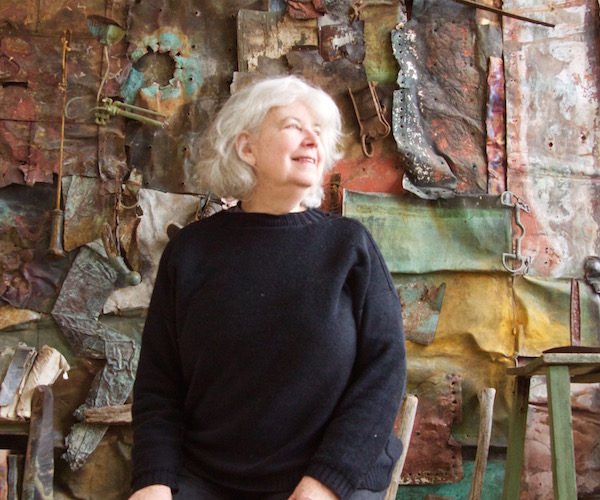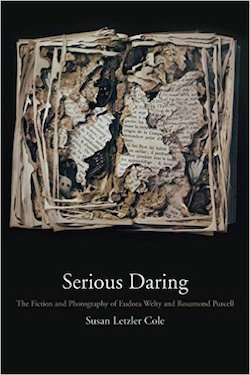Film Preview: The Weirdly Beautiful World of Rosamond Purcell — “An Art That Nature Makes”
Rosamond Purcell’s striking photographs are about surprising transformations, the unexpected magic of metamorphosis.

Artist Rosamond Purcell in her Somerville studio. Photo: Tim Jackson.
By Tim Jackson
Local artist Rosamond Purcell is an extraordinary collector, archivist, cataloger, writer, and photographer. A new documentary An Art That Nature Makes (screening at Cambridge’s Brattle Theatre on November 16 at 7:30 p.m.) explores the multi-ambidextrousness of her aesthetic vision, particularly her fascination with discarded, discredited, and/or dispatched objects. Her studio in Somerville (at the Brickbottom Artists’ Building) displays her eclectic sensibility: it is filled, floor to ceiling, with material from museums, junk yards, and ephemera markets. She also chooses, arranges, and then photographs material from natural history museums, endowing these pieces with a tranquility that makes us see them in fresh ways. Purcell’s photography is dedicated to staging transformations, the unexpected magic of metamorphosis. Once useful objects — turned into detritus by time and decay — become weird and beautiful, as do the remains of once living things.
“I’ve got to start getting the place organized” comments Purcell as she prepares for an open studio at Brickbottom which is set to take place two days after the film’s screening. “Every single piece in the studio was picked up for a reason,” the artist says. “They’re not in order right now, but they will be.” She goes on to elaborate on the origin of each item that she turns to. Her poetic touch is evident in the mini-collages that have been built on the surface of a rusted seed packet display as well as the metal collage of colors and textures that covers a far wall of the studio. Much of what is in the studio was found at Owl’s Head in Knox County, Maine on the property of the the late William Buckminster, whose antique/junkyard shop amounted to 11 acres of “battered household and industrial objects.” In her book Owl’s Head, Purcell vividly describes first seeing this mecca of found objects:
I had never seen so much stuff to which so much had happened. Fraying, tattered, cracked, flattened, tattered, dried, scrawny, collapsed, shredded, peeling, torn, warped, weathered, fading, bristling, moldy, clenched, tangled, punctured, battered, bashed-in, scooped out, withered, engorged, trampled, toppled, crushed, bald, listing, leaning, twisting, hanging, buried, wedged, jammed, impaled, strangling, stretched, disjointed, disemboweled, skinned, docked, gnawed, entrenched.
We talked about curating as well as the politics and challenges of putting together exhibitions. She has been a determined collector of objects for decades and agrees there is a new trend in the air regarding the value of collecting: a new Joseph Cornell show in London; The Keeper exhibit at The New Museum in NYC, which was dedicated to the act of preserving objects, artworks, and images; Nick Cave’s current Until exhibit at Mass MoCA. The museum describes the latter as “a dense sculptural field of metallic lawn ornaments … a crystal cloud topped by a private garden populated with birds, flowers, and black-face lawn jockeys … a cliff wall hand-woven with shoelaces and hundreds of thousands of colorful pony beads.”
Purcell also shows me several of the more than a dozen books in which her photography is featured, three of them collaborations with the late paleontologist and evolutionary theorist Stephen Jay Gould. She also opened up Special Cases, her volume on ‘monsters’ or human anomalies. “One thing I found was that the images on ancient Romanesque pillars weren’t just of geometrically perfect figures — there were also human anomalies.” As an example, she points to one of the pictures and explains: “Here is a man dancing with one head and two bodies.”
She then opens a book created in collaboration with Michael Witmore: Landscapes of the Passing Strange: Reflections from Shakespeare. She was given select quotations from the Bard’s plays and asked to create accompanying photographs. Purcell says that she “had to read the plays wall to wall.” The film explains and then demonstrates how the images were taken close up — reflections caught in the curved surface of mercury-lined bottles. The results are lyrical and surreal. Her book Egg & Nest is filled with gloriously gorgeous photos of the titular objects. A sample of the text: “Many of the eggs in the collections . . . boast elaborate markings. The markings resemble calligraphic art and beg a search for patterns and meaning in the scrawl.”
Asked about her latest project, Purcell explains: “A man from the 1840’s made a collection of presidential hair, people from circuses and performers, hottentots, sheep and on and on and on. They are all individually mounted in pieces of fancy paper. We’re doing a book on this hair for the Philadelphia Academy of Sciences.” Finally, we wander over to a collection of objects she is revisiting — pieces from a display dedicated to World War I.
An Art That Nature Makes focuses largely on Purcell’s photographic work. She uses natural light exclusively. “I want to see things as they are,” insists Purcell. “And natural light is full of variety. It falls on organic material in a generous way. It allows more of it to be seen. It’s the proper way to look at things.” Her prints, best seen in person, are printed on watercolor stock, which gives them a porous texture and a painterly quality.

For those unfamiliar with Purcell’s art, the documentary, which is directed by Molly Bernstein (Deceptive Practice: The Mysteries and Mentors of Ricky Jay), provides a solid introduction.The score by local composer John Kusiak, who has written music for Errol Morris, Rob Moss, PBS, HBO, and others, nicely compliments the mystery of Purcell’s images. However, those wanting an in-depth look at this artist’s motives and contexts should pick up the recent study Serious Daring: The Fiction and Photography of Eudora Welty and Rosamond Purcell by Susan Letzler Cole. The University of Arkansas Press describes its book as “bringing together two visionary modern artists of word and image … their mirror-image career trajectories towards and away from the photograph, Welty’s abandonment of photography for the language of fiction and Purcell’s of fictional prose for the language of light.”
I expressed surprise that neither the Museum of Fine Arts nor the ICA have mounted an exhibit in conjunction with the new film. Purcell responds that she is not interested in self-promotion. She is particularly wary that, by having attention drawn to her work, she will be singled out: “Yesterday, two different people recognized me and I didn’t like it one bit. I don’t think I’m going to like that part.”
Tim Jackson was an assistant professor of Digital Film and Video for 20 years. His music career in Boston began in the 1970s and includes some 20 groups, recordings, national and international tours, and contributions to film soundtracks. He studied theater and English as an undergraduate, and has also has worked helter skelter as an actor and member of SAG and AFTRA since the 1980s. He has directed three feature documentaries: Chaos and Order: Making American Theater about the American Repertory Theater; Radical Jesters, which profiles the practices of 11 interventionist artists and agit-prop performance groups; When Things Go Wrong: The Robin Lane Story, and the short film The American Gurner. He is a member of the Boston Society of Film Critics. You can read more of his work on his blog.
Tagged: An Art That Nature Makes, Brattle Theatre, documentary, Molly Bernstein, Owl's Head
